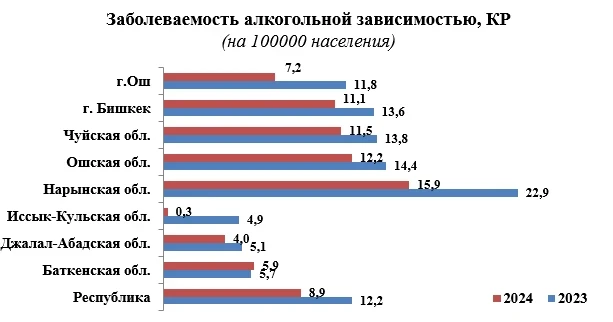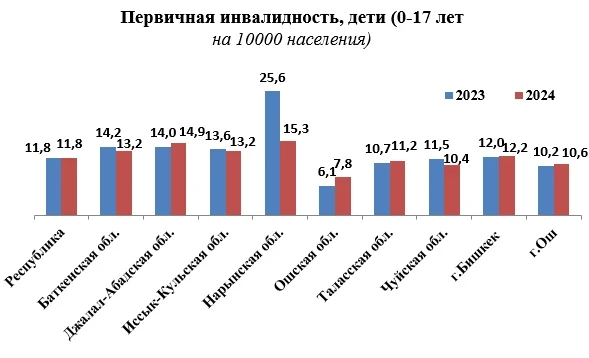The majority of foreign investors in Kyrgyzstan are companies from CIS countries. In 2024, 56.4% of enterprises with foreign participation had partners from these countries (a total of 3,227 companies), while 43.6% collaborated with investors from other states. The largest number of joint ventures was established with capital from Russia (37.1%), followed by China (16.3%), Kazakhstan (11.9%), and Turkey (8.1%). Among fully foreign companies, investors from the CIS also dominate — about 57% of such enterprises are controlled by them.
Sectors and Location
Foreign companies are represented in all sectors of the economy; however, their distribution across industries is uneven. Almost half of them operate in the trade and auto service sector, while there are significantly fewer in industry and other areas. In 2024, the highest share of foreign capital was in wholesale and retail trade (including auto repair) — 48.2% of the total. The ratio in other sectors is as follows:- industry – 11.3%;
- professional, scientific, and technical activities – 9.1%;
- transport and cargo storage – 5.2%;
- construction – 4.8%.
The contribution of foreign enterprises to the economy of Kyrgyzstan is significant. In 2024, they produced gross value added (GVA) amounting to 224.7 billion soms, which accounts for 14.7% of the country's GDP. In comparison, in 2023, this figure was 210.2 billion soms (15.8% of GDP). Despite a slight decrease in share, the absolute volume of GVA created by foreign companies increased, exceeding 14% of the economy.
Workforce and Salaries
Significant numbers of employees work in enterprises with foreign investments, and this figure has slightly increased in recent years. In 2024, the number of workers reached 63,000, which is 2,100 more than in 2023. Compared to 2020, the growth was only 1,600 people over five years, indicating that the increase in the number of companies did not correspond to a proportional growth in jobs. About 38% of all workers in foreign companies are concentrated in industry, with wholesale and retail trade (including auto service) coming in second with 30% of employees.Salaries in foreign companies are significantly higher than the national average. In 2024, the average monthly nominal salary in such enterprises was 59,690 soms, which is approximately 1.7 times higher than the average level in the republic. This means that employees of foreign companies earn on average 70% more than the overall economy. In some sectors, salaries are even higher. The highest earnings in 2024 were observed in the following sectors:
Financial Results
The financial results of enterprises with foreign investments in 2024 were positive. Overall, they reported a net profit of 61 billion soms, which is 50% more than in 2023. The main part of the profit was provided by several key sectors. The largest profit was recorded by companies in the manufacturing industry — 31.5 billion soms, followed by trading companies with 24.3 billion soms. Significant profits were also shown by telecommunications enterprises (about 6.5 billion) and the extractive sector (approximately 4.2 billion soms). Energy sector companies, however, reported losses of 16.6 billion soms.According to statistics, only about a third of companies reported profitability — 31.6% of them were profitable, generating a total of 92.7 billion soms. At the same time, nearly 30% of enterprises were unprofitable, accounting for 29.8% with a total debt of 31.6 billion soms. The remaining companies ended the year with minimal losses or unchanged results. The share of profitable companies slightly decreased compared to the previous year, although the absolute volume of their profits increased.
Particular attention should be paid to the contribution of foreign companies to industrial production: in 2024, they produced goods worth 179.7 billion soms, which accounted for 30% of the total industrial output in Kyrgyzstan. This means that every third product or service of an industrial nature was produced by enterprises with foreign capital.
Foreign Direct Investment
In 2024, there was a significant increase in the inflow of foreign direct investment (FDI) into companies with foreign capital in the Kyrgyz economy. According to the National Statistical Committee, the volume of incoming investments amounted to $1,029.7 million, which is 21.9% more than in 2023 and almost 1.9 times more than in 2020. Thus, over five years, the inflow of FDI into foreign business in Kyrgyzstan has nearly doubled.The majority of these investments are concentrated in several key sectors. In 2024, 86.3% of all FDI went to the manufacturing industry, the extractive sector, wholesale and retail trade, and financial intermediation. In comparison, in 2020, these same key sectors accounted for 76.6% of all FDI, indicating further concentration in the investment structure. In 2023, this share was 86.8%.
Investors increased their investments in trade and industry. The volume of FDI in trade enterprises grew more than 2.1 times in 2024, while in the manufacturing industry, it increased by approximately 1.5 times. Investments in the financial sector also rose by 14%. At the same time, less funding flowed into the extractive sector — the inflow to mining companies decreased by about half.
Geographically, there is a growing interest from both near and far abroad. The inflow of FDI from countries outside the CIS increased by 4.1% in 2024, mainly due to investments from Luxembourg, Germany, Cyprus, Turkey, and China. Investments from CIS countries increased almost 1.6 times, primarily due to contributions from Russia, Azerbaijan, Kazakhstan, and Uzbekistan.
The list of the largest investing countries in 2024 is as follows:
Capital Investments
In addition to the inflow of foreign investments, it is also important to assess the level of capital investments made by the enterprises themselves. In 2024, companies with foreign investments allocated 34.9 billion soms to fixed assets. This is 1.5 times more than in 2023, indicating an increase in investment activity in the country. However, compared to 2020, the volume of capital investments decreased almost threefold. This indicates a decline after peak figures five years ago, with subsequent growth only in 2024, which still has not reached the level of 2020. Over the past five years, the structure of funding sources has remained stable. The main sources of funds for investments in fixed assets were the companies' own funds, foreign loans, and foreign direct investments, which accounted for 72.2% to 95.8% of all investments. This means that most projects are financed through internal revenues and foreign loans.In 2024, the volume of capital investments by foreign companies increased in most regions, except for the Talas region. An increase in investments was also noted in the Jalal-Abad, Naryn, and Osh regions.
In 2024, these funds were primarily directed towards the development of raw material and infrastructure sectors. More than 42% of all capital investments were focused on the construction of facilities in the mining sector, 18% on the modernization of manufacturing industries, and about 16.5% on projects in electricity and gas supply. A significant share of investments (13.4%) was also directed towards telecommunications and IT projects. Thus, the main areas of capital investments by foreign business include extraction, manufacturing, energy, and communications.
Foreign Trade
Companies with foreign investments actively participate in Kyrgyzstan's foreign economic activity. In 2024, their total foreign trade turnover amounted to about $3.2 billion, increasing by 4.2% compared to 2023. Foreign firms account for 17.9% of the total trade turnover of the country, which is almost one-fifth. However, the trade balance in this segment remains negative: imports exceed exports. In 2024, foreign companies imported more goods than they exported, with a negative balance of $1.4 billion (compared to $1.3 billion the previous year).Exports from companies with foreign capital in 2024 slightly increased to $895.9 million, which is 5.3% higher than in 2023. The main growth came from supplies to CIS countries, which increased by 11.3%, while exports to non-CIS countries slightly decreased by 1.3%. As a result, more than half of the export revenue of these companies came from supplies to the CIS — 55.7% compared to 44.3% to other countries.
The imports of foreign enterprises significantly exceed exports: in 2024, the volume of imported goods amounted to nearly $2.3 billion, which is 3.7% more than in 2023. Imports from CIS countries increased by 15.7%, while purchases from far abroad decreased by 10.3%. Thus, 60.1% of all imports by companies with foreign capital came from CIS countries, while 39.9% came from sources outside the CIS.
Over the past five years, the volumes of foreign trade by foreign companies have significantly increased: from 2020 to 2024, exports doubled (by $452 million), while imports increased nearly 1.8 times (by $1 billion). The growth in exports was due to increased supplies of certain goods, such as glass containers, telecommunications equipment, non-alcoholic beverages, and ore concentrates. Imports increased due to higher purchases of food products, equipment for soil processing, petroleum products, and pharmaceuticals. Thus, foreign enterprises expanded both directions, despite the fact that dependence on imports remains significantly higher than export capabilities, which is reflected in the negative trade balance.
It is important to note that the main trading partners of foreign companies in Kyrgyzstan remain traditional markets. From 2020 to 2024, enterprises with foreign investments most frequently traded with Russia, Kazakhstan, China, Uzbekistan, and Turkey, which consistently held leading positions in both exports and imports, reflecting the geographical structure of the foreign trade of Kyrgyz foreign business.







